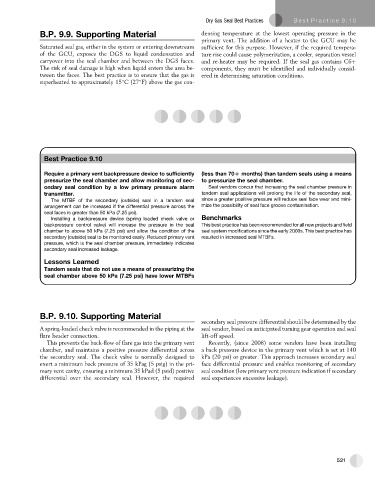Page 550 - Subyek Teknik Mesin - Forsthoffers Best Practice Handbook for Rotating Machinery by William E Forsthoffer
P. 550
Dry Gas Seal Best Practices Best Practice 9 .10
B.P. 9.9. Supporting Material densing temperature at the lowest operating pressure in the
primary vent. The addition of a heater to the GCU may be
Saturated seal gas, either in the system or entering downstream sufficient for this purpose. However, if the required tempera-
of the GCU, exposes the DGS to liquid condensation and ture rise could cause polymerization, a cooler, separation vessel
carryover into the seal chamber and between the DGS faces. and re-heater may be required. If the seal gas contains C6þ
The risk of seal damage is high when liquid enters the area be- components, they must be identified and individually consid-
tween the faces. The best practice is to ensure that the gas is ered in determining saturation conditions.
superheated to approximately 15 C (27 F) above the gas con-
Best Practice 9.10
Require a primary vent backpressure device to sufficiently (less than 70D months) than tandem seals using a means
pressurize the seal chamber and allow monitoring of sec- to pressurize the seal chamber.
ondary seal condition by a low primary pressure alarm Seal vendors concur that increasing the seal chamber pressure in
transmitter. tandem seal applications will prolong the life of the secondary seal,
The MTBF of the secondary (outside) seal in a tandem seal since a greater positive pressure will reduce seal face wear and mini-
arrangement can be increased if the differential pressure across the mize the possibility of seal face groove contamination.
seal faces is greater than 50 kPa (7.25 psi).
Installing a backpressure device (spring loaded check valve or Benchmarks
backpressure control valve) will increase the pressure in the seal This best practice has been recommended for all new projects and field
chamber to above 50 kPa (7.25 psi) and allow the condition of the seal system modifications since the early 2000s. This best practice has
secondary (outside) seal to be monitored easily. Reduced primary vent resulted in increased seal MTBFs.
pressure, which is the seal chamber pressure, immediately indicates
secondary seal increased leakage.
Lessons Learned
Tandem seals that do not use a means of pressurizing the
seal chamber above 50 kPa (7.25 psi) have lower MTBFs
B.P. 9.10. Supporting Material
secondary seal pressure differential should be determined by the
A spring-loaded check valve is recommended in the piping at the seal vendor, based on anticipated turning gear operation and seal
flare header connection. lift-off speed.
This prevents the back-flow of flare gas into the primary vent Recently, (since 2008) some vendors have been installing
chamber, and maintains a positive pressure differential across a back pressure device in the primary vent which is set at 140
the secondary seal. The check valve is normally designed to kPa (20 psi) or greater. This approach increases secondary seal
exert a minimum back pressure of 35 kPag (5 psig) in the pri- face differential pressure and enables monitoring of secondary
mary vent cavity, ensuring a minimum 35 kPad (5 psid) positive seal condition (low primary vent pressure indication if secondary
differential over the secondary seal. However, the required seal experiences excessive leakage).
521

